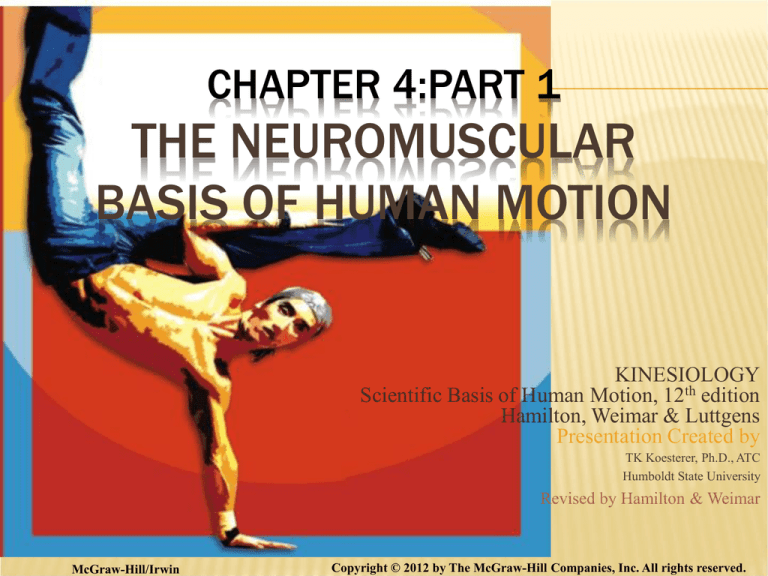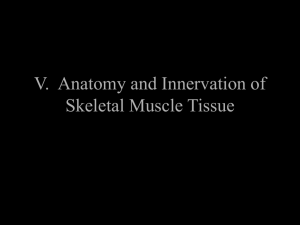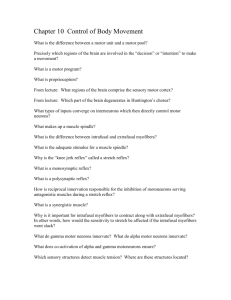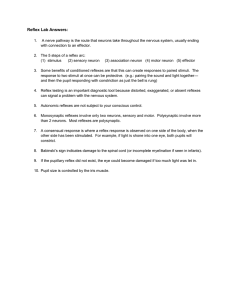
CHAPTER 4:PART 1
THE NEUROMUSCULAR
BASIS OF HUMAN MOTION
KINESIOLOGY
Scientific Basis of Human Motion, 12th edition
Hamilton, Weimar & Luttgens
Presentation Created by
TK Koesterer, Ph.D., ATC
Humboldt State University
Revised by Hamilton & Weimar
McGraw-Hill/Irwin
Copyright © 2012 by The McGraw-Hill Companies, Inc. All rights reserved.
OBJECTIVES
1. Name and describe the function of the basic structure of the
nervous system.
2. Explain how gradations in strength of muscle contraction and
precision of movements occur.
3. Name and define the receptors important in musculoskeletal
movement.
4. Explain how the various receptors function, and describe the
effect each has on musculoskeletal movement.
5. Describe reflex action, and enumerate and differentiate among
the reflexes that affect musculoskeletal action.
6. Demonstrate a basic understanding of volitional movement by
describing the nature of the participation of the anatomical
structures and mechanisms.
7. Perform an analysis of the neuromuscular factors influencing the
performance of a variety of motor skills.
4-2
THE NERVOUS SYSTEM AND BASIC NERVE
STRUCTURES
Central nervous system (CNS)
A. Brain
B. Spinal cord
II. Peripheral nervous system (PNS)
A. Cranial nerves (12 pairs)
B. Spinal nerves (31 pairs)
III. Autonomic nervous system
A. Sympathetic
B. Parasympthetic
I.
4-3
CEREBRAL CORTEX
Motor Cortex
Sensory Cortex
4-4
NEURONS
A single nerve cell consists
of a cell body and one or
more projections.
Axons: Carry impulses away
from cell body.
Dendrites: Carry impulses
toward cell body.
Fig 4.1
4-5
MOTOR NEURONS
Situated in anterior horns of spinal cord
Dendrite
that synapses with sensory neurons or
connector neurons.
Axon emerges from the spinal cord, travels by
way of a peripheral nerve to muscle.
Each terminal branch ends at the motor end
plate of a single muscle fiber
4-6
SENSORY NEURONS
Situated in a dorsal root
ganglion just outside the
spinal cord.
Neuron may terminate in
spinal cord or brain.
A long peripheral fiber
comes from a receptor.
Fig 4.1b
4-7
CONNECTOR NEURONS
Exist completely within the CNS.
Serve as connecting links.
May be a single neuron, connecting sensory to
motor neurons.
OR
An intricate system of neurons, whereby a
sensory impulse may be relayed to many
motor neurons.
4-8
NERVES
A bundle of fibers, enclosed
within a connective tissue sheath,
for transmission of impulses.
A typical spinal nerve consists of:
Motor, outgoing (efferent) fibers
Sensory, incoming (afferent) fibers
Each spinal nerve is attached to
spinal cord by an anterior (motor)
root and a posterior (sensory) root
Posterior root bears a ganglion –
a collection of cell bodies
4-9
SPINAL NERVES
31 pairs – exit
both sides of
the vertebral
column
8
Cervical
12 Thoracic
5 Lumbar
5 Sacral
1 Coccyx
4-10
THE SYNAPSE
Connection between neurons.
May be thousands between any
two neurons.
Is a proximity of the membrane
of an axon to the membrane of a
dendrite or cell body.
The more often a synapse is
used the faster a signal will pass
through it.
The greater the number of
synapses from receptor to
effector, the longer the time from
stimulus to response.
Transmission across the
synapse depends on a
chemical transmitter.
Substance diffuses the
synapse and produces an
action potential in the
postsynaptic neuron.
4-11
ACTION POTENTIALS
Threshold level is the minimum level of stimulus
(chemical transmitter) necessary to initiate or
propagate a signal.
Facilitation – an excitatory stimulus
Inhibition – an inhibitory stimulus
Stimulus may be from more than one neuron
The sum total of excitatory and inhibitory impulses
determine if the postsynaptic neuron will produce an
action potential.
4-12
MUSCLE INNERVATION
4-13
THE MOTOR UNIT
Consists of a single motor
neuron and all the muscle
fibers its axon supplies.
All muscle fibers in a motor
unit are of the same muscle
fiber type.
Vary widely in the number of
muscle fibers.
Gastrocnemius: 2,000 or more muscle fibers per motor unit.
Eye muscles: may have fewer than 10 fiber per motor unit.
A small ratio of muscle fibers to motor neurons is capable of
more precise movements.
Size of the motor unit has a direct bearing on the precision of
movement.
4-14
GRADATIONS IN THE STRENGTH OF MUSCULAR
CONTRACTIONS
Experience tells us that the same muscles
contract with various gradations of strength.
How do they adjust to such extremes?
Number
of motor units that are activated.
Frequency of stimulation.
4-15
GRADATIONS IN THE STRENGTH OF
MUSCULAR CONTRACTIONS
All-or-None Principle: If the stimulus is of threshold value, all
muscle fibers of the motor unit will contract.
Motor unit recruitment: has an orderly sequence:
Smaller slow twitch fibers are recruited first.
They have lower thresholds
Larger fast twitch fibers are recruited later.
They have higher thresholds
At low frequency stimuli, muscle fibers relax between impulses.
At high frequency stimuli, fibers do not have time to relax and
result in summation or maximal contraction.
A combination of maximum number of fibers stimulated and
high frequency of stimuli results in a maximal strength of
contraction.
4-16
SENSORY RECEPTORS
Respond to different
stimuli
Exteroceptors:
near body
surface stimuli come
from outside the body.
Interoceptors: sense
heat, cold, pain and
pressure.
Fig 4.5
4-17
PROPRIOCEPTORS
Stimulated by body
movements.
Transmit information to
CNS.
Two primary categories:
Muscle
receptors
Joint & skin receptors
Fig 4.6
4-18
MUSCLE PROPRIOCEPTORS:
MUSCLE SPINDLES
Located in muscle belly, parallel with
fibers.
When stretched, sensory nerve sends
impulses to CNS, which activates the
motor neurons facilitating contraction of
the same muscle.
More spindles are located in muscles
controlling precise movements.
Extrafusal fibers “regular” muscle fibers.
Intrafusal fibers muscle fibers inside
spindles.
4-19
MUSCLE PROPRIOCEPTORS
MUSCLE SPINDLES
Spindles contains two type of nerve endings.
Primary or annulospiral endings: coiled around noncontractile midsection.
Flower-spray endings: at end of non-contractile
midsection.
Sensitive to velocity of change (phasic).
Sharp decline in impulses with static length change.
Respond to static muscle length.
Impulses directly proportional to change in length.
Gamma motor neurons: stimulate the intrafusal fibers
to contract, shortening the muscle spindle.
4-20
MUSCLE PROPRIOCEPTORS
GOLGI TENDON ORGAN (GTO)
Embedded “in series” in
the tendon.
As tension in tendon
increases GTO is
activated.
Signals CNS to relax
muscle.
Protective mechanism.
4-21
JOINT AND SKIN PROPRIOCEPTORS
PACINIAN CORPUSCLES
In regions around joint
capsules, ligament, and
tendons sheaths.
End-organ has concentric
layers of capsule.
Activated by joint angle
changes & pressure.
Transmits impulses for only
a very brief time.
4-22
JOINT AND SKIN PROPRIOCEPTORS
RUFFINI ENDINGS
In deep layers of skin and joint capsule.
Activated by mechanical deformation.
Stimulated strongly by sudden joint
movement.
Sense joint position and changes in joint
angle.
The CNS knowing which receptors is
stimulated can tell the joint angle.
4-23
JOINT AND SKIN PROPRIOCEPTORS
CUTANEOUS RECEPTORS
Meissner corpuscles: touch
Pacinian corpuscles: pressure
Free nerve endings: pain
4-24
LABYRINTHINE AND NECK PROPRIOCEPTORS
Labyrinthine system: Concerned with sense of balance.
Consists of utricle, saccule, and semicircular canals.
Filled with endolymph whose motion triggers hair cells.
Contain otoliths that shift with gravity.
Utricle: sensitive to linear acceleration and head position with
respect to gravity.
Semicircular canals: sensitive to angular acceleration.
Three canals oriented in different planes at right angles to
each other.
Joint receptors of the neck: sensitive to angle between the
body and the head.
Prevent labyrinthine proprioceptors from producing feeling
of imbalance.
4-25
LABYRINTHINE SYSTEM
Semicircular Canals
Utricle
4-26
REFLEX MOVEMENT
A specific pattern of response without volition
from the cerebrum.
Stimulus - receptor organ - sensory neuron motor neuron - muscle (response)
Connector neurons often used.
4-27
EXTEROCEPTIVE REFLEXES
EXTENSOR THRUST REFLEX
Stimulus - pressure.
Receptor -Pacinian corpuscles.
Response - contraction of the extensor muscles
of that limb.
Fig 4.11
4-28
EXTEROCEPTIVE REFLEXES
Flexor Reflex:
Stimulus
- pain, noxious stimuli.
Receptor - free nerve endings.
Response - Quick withdrawal from source of pain
(flexion).
Crossed Extensor Reflex:
Stimulus
- flexor reflex or un-weighting
Response - opposite extensors contract for support.
4-29
PROPRIOCEPTIVE REFLEXES
STRETCH REFLEX
A reflex contraction of stretched muscle and
synergists and relaxation of antagonists.
Phasic Response:
Stimulus - high velocity stretch.
Receptor - annulospiral endings of muscle
spindle.
Response
- facilitates proportional contraction of
stretched muscle.
4-30
PROPRIOCEPTIVE REFLEXES
STRETCH REFLEX
Knee jerk response
Sudden addition of weight to hand, elbow at
90°.
Biceps
stretches, then contracts.
Weight dropped
Muscle contracts
4-31
PROPRIOCEPTIVE REFLEXES
STRETCH REFLEX
Tonic Response:
Stimulus
- Slow, sustained stretch(>.02 s).
Receptor - flower spray endings of muscle
spindle.
Response - gamma efferent system resets
spindle tension using intrafusal fiber contraction
or relaxation.
4-32
PROPRIOCEPTIVE REFLEXES
STRETCH REFLEX
Phasic Response
Application:
Phasic
preparatory phase
can take advantage of
the stretch reflex.
Results in a stronger
contraction.
Postural control
feedback.
Fig 4.13a
4-33
PROPRIOCEPTIVE REFLEXES
STRETCH REFLEX
Tonic Response Application:
Slow
preparatory phase
should be used when the
desired outcome is accuracy.
Result in a low level,
sustained contraction.
Fig 4.13b
4-34
TENDON REFLEX
Stimulus - high level of stretch, due to muscle
stretch, or muscle contraction.
Receptor - Golgi tendon organ.
Response - relaxation of stretched muscle and
facilitation of antagonist.
Feedback mechanism to control tension.
May effect skills of beginners until GTO
threshold develops.
4-35
LABYRINTHINE AND NECK REFLEXES
Righting Reflex:
Stimulus
- head not upright with respect to gravity.
Receptor - utricle and semicircular canals.
Response - bring the head to the upright position.
This reflex is integrated with movements of the
arms and legs as described in the tonic neck
and labyrinthine reflexes.
4-36
LABYRINTHINE AND NECK REFLEXES
Tonic Neck Reflex (TNR):
Symmetrical response:
Stimulus - head/neck (H/N) flexion/hyperextension.
Receptor - neck receptors.
Response - H/N flexion facilitates upper extremity flexion;
H/N hyperextension facilitates upper extremity extension.
Tonic Neck Reflex (TNR):
Asymmetrical response:
Stimulus - head/neck (H/N) rotation.
Receptor - neck receptors.
Response - H/N rotation facilitates upper extremity chin
side abduction & extension; back of head side adduction
and flexion.
4-37
LABYRINTHINE AND NECK REFLEXES
In both TNR responses, action in the lower
extremities is in opposition to the upper extremities.
The TNR is a primitive reflex and not easily elicited in
adults. May still be observed to be facilitory
(throwing motions) or inhibitory (golf drive).
Tonic labyrinthine reflexes:
Response is in opposition to the TNR.
Most apparent in the lower extremity.
4-38
VOLITIONAL MOVEMENT
CNS: LEVELS OF CONTROL
1. Cerebral cortex: where consciousness occurs, initiation of
voluntary movement.
2. Basal ganglia: responsible for homeostasis, coordination &
some learned acts of posture.
3. Cerebellum “little brain”: key role in sensory integration,
regulates timing & intensity of muscle contraction.
4. Brain stem: arousal and monitoring of physiological
parameters, key facilitory and inhibitory centers.
5. Spinal cord: contains cell bodies of lower motor neurons,
common pathway between CNS & PNS, final point for
integration and control.
Functions of the 5 levels overlap depending on classification
scheme used
4-39
KINESTHESIS
The conscious awareness of position of body
parts and the amount and rate of joint
movement.
Without rapid transmission & processing,
accurately controlled movements could not
proceed.
Kinesthetic perception and memory are the
basis for voluntary movement and motor
learning.
4-40
RECIPROCAL INHIBITION
When motor neurons are transmitting impulses to an agonist,
antagonistic are simultaneously & reciprocally inhibited.
Antagonists remain relaxed & agonists contract without opposition.
Automatic in reflexes & familiar movements.
In more complicated movements this depends on the degree of skill
developed by performer.
Most frequently appears in movement when there is uncertainty about
movement task.
Practice increases familiarity, and coactivation decreases in favor of
reciprocal inhibition.
Efficiency of movement increases.
Coactivation also occurs to maintain joint stiffness.
4-41
NEUROMUSCULAR ANALYSIS
Muscle-response patterns of well-learned
motor skills involve the integrated action of
many reflexes and the inhibition of others.
After repeated viewing, students should be
able to name and discuss the reflexes that
could be acting at various points in each
phase.
4-42







